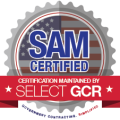Meteorcomm can help you manage changes needed as a result of 900 MHz changes by the Federal Communications Commission.
Compliance with the FCC re-allocation of the 900 MHz (ATCS) spectrum will require changes to all railroad systems using this spectrum. In fact, your railroad is likely already planning migration of Centralized Traffic Control (CTC) away from the 900 MHz ATCS spectrum to meet the new regulations.
Long before the announcement of the 900 MHz changes by the FCC, we at Meteorcomm were hard at work on a solution. Our solution involves using CTC over Interoperable Train Control Messaging (ITCM). This allows railroads to use their existing Positive Train Control (PTC) infrastructure for CTC. This helps expedite the needed 900 MHz migration. That provides cost savings, better reliability, and frees up the 900MHz (ATCS) frequency spectrum for other applications.
But how? By allowing railroads to harness the power of our Interoperable Train Control Network’s built-in capabilities for multiple-data transports and agent support.
Why CTC over ITCM?
CTC over ITCM reduces costs in a number of ways. First, by eliminating expenses related to maintaining the aging 900 MHz (ATCS) infrastructure. CTCover ITCM also eliminates the need to upgrade, or replace current ATCS radios used at CTC locations in order to meet the FCC 900 MHz re-organization.
Using the PTC communications infrastructure improves reliability with the inherent capabilities for use of alternate communications paths for ITCM (and CTC) messages. We also developed and tested our components to provide high availability.
The CTC over ITCM console combines an intuitive interface with powerful monitoring and trouble-shooting capabilities.
How it works
The Meteorcomm CTC over ITCM solution consists of three interrelated software subsystems:
- The Office Gateway, which translates message formats between the dispatch system and ITCM.
- The Field Gateway, which translates message formats between the wayside device and ITCM.
- The Maintenance Console, a SMS client, which monitors and troubleshoots the system.
Let’s take a deeper look:
CTC Office Gateway Component
The Office Gateway’s highly available software application translates message formats between the dispatch system and ITCM by connecting directly to the Code Server. From there, the gateway instantly and easily sends messages to and from the ITCM stack. This allows railroads to support migration to the CTC over ITCM specification without the need to update their Code Server.
CTC Field Gateway Component
Field Gateway software translates message formats between the wayside devices and ITCM. It does this by physically connecting to the wayside equipment. From there it handles low-level flow control and converts messaging formats configured in the Code Unit as needed. This enables field migration of CTC sites without needing to make any other changes.
CTC over ITCM Maintenance Console
The CTC Systems Management Console (CTCSM Console) monitors and troubleshoots the entire system. The console includes essential tests that can be used in combination with visual cues to quickly isolate issues. This allows operators to monitor the end to end communications of the system including the Office and Field Gateways.
These three software subsystems combine to create an incredible solution to the changes ahead by reducing costs, increasing reliability, and complying with the AAR’s latest specifications.
Ready for advanced wayside messaging? We’re ready to help you solve your technical challenges.
